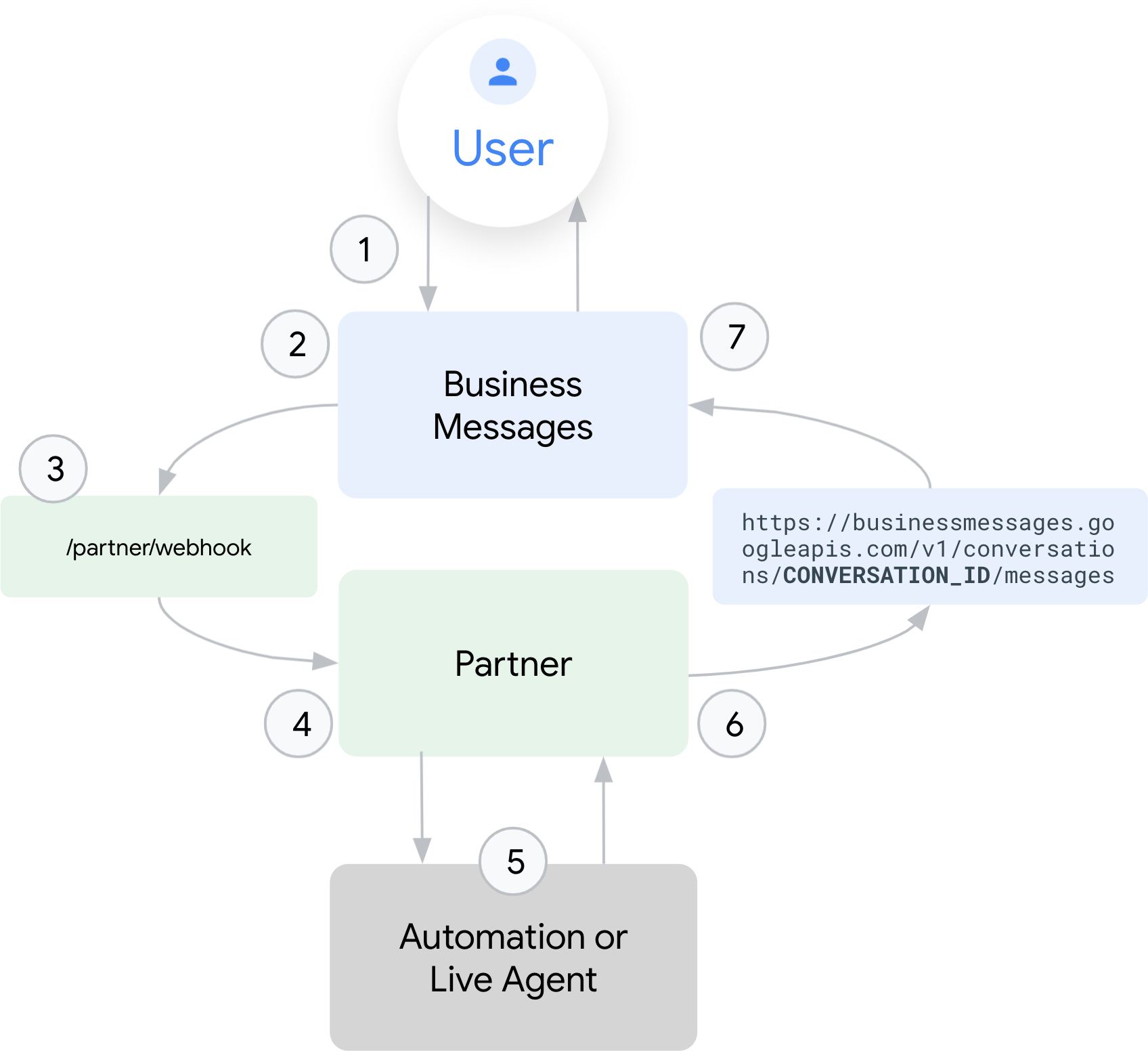ผู้ใช้สามารถส่งข้อความไปยังตัวแทน และตัวแทนสามารถส่งข้อความถึงผู้ใช้ได้ แต่ยังมีมากกว่านั้น สําหรับแต่ละข้อความ อาจมีหลายฝ่าย ที่เกี่ยวข้อง
- ผู้ใช้เริ่มการสนทนากับตัวแทนผ่านจุดแรกเข้าใน Search, Maps รวมถึงลิงก์และเว็บไซต์ที่จัดการโดยแบรนด์ ผู้ใช้ต้องลงชื่อเข้าใช้บัญชี Google แต่ระบบจะแชร์เฉพาะชื่อผู้ใช้กับพาร์ทเนอร์ ข้อความของผู้ใช้ได้รับการเข้ารหัสโดยใช้ TLS
Business Messages ทําหน้าที่เป็นเลเยอร์ระหว่างผู้ใช้และพาร์ทเนอร์เพื่อปกป้องความเป็นส่วนตัวของผู้ใช้ เลเยอร์นี้ช่วยดูแลไม่ให้มีการแชร์ข้อมูลบัญชี Google ของผู้ใช้กับคู่สนทนาหรือตัวแทนแบบเรียลไทม์โดยถอดรหัสและเข้ารหัสข้อความขาเข้าและขาออกแต่ละรายการ รวมทั้งแมปบัญชี Google ของผู้ใช้กับรหัสการสนทนา
Google จัดเก็บข้อความที่เข้ารหัสไว้เพื่อให้ส่งและซิงค์ข้อมูลระหว่างอุปกรณ์ของผู้ใช้ได้ คุณจะแชร์ข้อความที่จัดเก็บไว้เหล่านี้กับบุคคลที่สามไม่ได้ เข้าถึงได้โดยใช้รหัส Google ของผู้ใช้เท่านั้น
ตัวแทนคือตัวแทนของแบรนด์ตามที่สร้างและจัดการโดยพาร์ทเนอร์
พาร์ทเนอร์จัดการตัวแทนในนามของแบรนด์ พาร์ทเนอร์จะได้รับข้อความขาเข้าในเว็บฮุคที่ระบุ, กําหนดเส้นทางข้อความขาเข้าไปยังระบบอัตโนมัติหรือตัวแทนแบบเรียลไทม์เพื่อเขียนคําตอบ และส่งข้อความขาออกไปยัง Business Messages API
การทํางานอัตโนมัติจะจัดการข้อความสําหรับผู้ใช้โดยไม่มีการมีส่วนร่วมจากมนุษย์
Agent แบบสดจะจัดการข้อความที่ผู้ใช้ต้องมีการมีส่วนร่วมจากมนุษย์
คู่สัญญาแต่ละฝ่ายมีบทบาทในการส่งและรับข้อความในการสนทนา กระบวนการรับส่งข้อความตั้งแต่ต้นจนจบจะเริ่มต้นขึ้นเมื่อผู้ใช้รับส่งข้อความกับตัวแทน และจบลงด้วยการที่ผู้ใช้ได้รับการตอบกลับจากตัวแทน

- ผู้ใช้เริ่มการสนทนาและส่งข้อความถึงตัวแทน Business Messages
- Business Messages จะกําหนดรหัสให้กับการสนทนา รหัสการสนทนาคงอยู่ถาวรและไม่ซ้ํากันทั้งผู้ใช้และตัวแทน หากผู้ใช้รายเดิมติดต่อ ตัวแทนคนอื่น การสนทนานั้นจะต้องมีรหัสการสนทนาที่ต่างออกไป
- Business Messages ส่งข้อความที่เข้ารหัสไปยังเว็บฮุคของพาร์ทเนอร์ ข้อความจะมีรหัสการสนทนาที่ไม่ซ้ํากัน รหัสตัวแทน รหัสข้อความ และข้อมูลบริบทเกี่ยวกับแหล่งที่มาของการสนทนา
- พาร์ทเนอร์ได้รับข้อความและกําหนดเส้นทางข้อความไปยังระบบอัตโนมัติหรือตัวแทนแบบเรียลไทม์
- ระบบอัตโนมัติจะสร้างการตอบกลับข้อความของผู้ใช้โดยอัตโนมัติ หรือ Agent แบบสดที่มีสิทธิ์เข้าถึงการสนทนาจะเห็นข้อความของผู้ใช้และจะสร้างการตอบกลับที่สอดคล้องกัน
- พาร์ทเนอร์ส่งการตอบกลับไปยัง Business Messages API ที่มีรหัสการสนทนาเป็นผู้รับ
- Business Messages จะถอดรหัสและเข้ารหัสข้อความอีกครั้ง และจับคู่รหัสการสนทนากับบัญชี Google ของผู้ใช้ แล้วส่งข้อความดังกล่าวให้กับผู้ใช้
